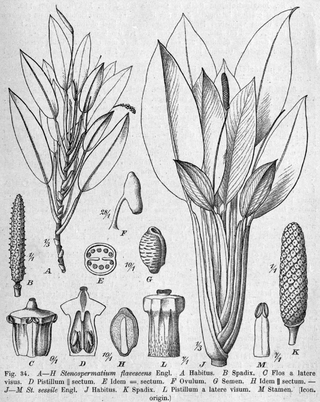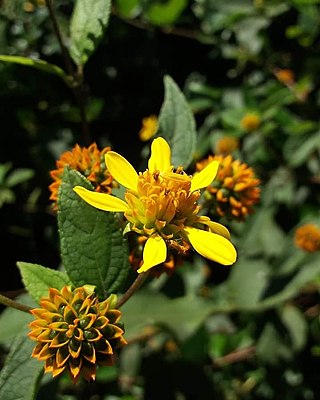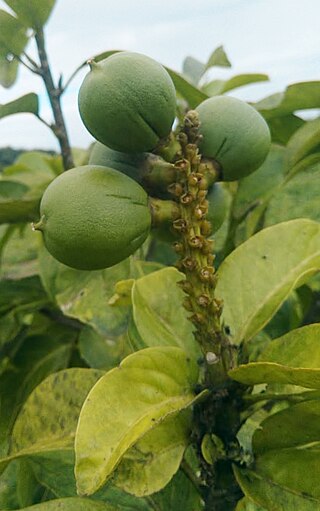
Ecuador, officially the Republic of Ecuador, is a country in northwestern South America, bordered by Colombia on the north, Peru on the east and south, and the Pacific Ocean on the west. Ecuador also includes the Galápagos Islands in the Pacific, about 1,000 kilometers (621 mi) west of the mainland. The country's capital and largest city is Quito.

Putumayo is a department of Southern Colombia. It is in the south-west of the country, bordering Ecuador and Peru. Its capital is Mocoa.

Prunus serotina, commonly called black cherry, wild black cherry, rum cherry, or mountain black cherry, is a deciduous tree or shrub of the genus Prunus. Despite being called black cherry, it is not very closely related to the commonly cultivated cherries such as sweet cherry, sour cherry and Japanese flowering cherries which belong to Prunus subg. Cerasus. Instead, P. serotina belongs to Prunus subg. Padus, a subgenus also including Eurasian bird cherry and chokecherry. The species is widespread and common in North America and South America.

Astroblepus is a genus of fish in the family Astroblepidae found in South America and Panama. This genus is the only member of its family. These catfishes are primarily found in torrential streams in the Andean area. Astroblepus pholeter and A. riberae are troglobites adapted to living in subterranean water systems. These species are typically small, less than 10 cm (4 in). The largest species reaches 30 cm (1 ft). These fish have suckermouths like those of loricariids. They have two pairs of barbels, maxillary and nasal. The dorsal fin spine lacks a locking mechanism. These fish also have odontodes, tiny teeth on their skin. All species exhibit a conical, pointy type on their fin rays like that found in other loricarioids; other species also exhibit a blunt type that is only found on their skin.
Podocarpus celatus is a species of conifer in the family Podocarpaceae. It is found in the Amazon rainforest.

Alnus acuminata is a species of deciduous tree in the Betulaceae family. It is found in montane forests from central Mexico to Argentina.

Rhodospatha is a genus of plant in family Araceae. It is native to South America, Central America, and southern Mexico.

Stenospermation is a genus of plant in family Araceae native to South America and Central America.

Parajubaea cocoides, the mountain coconut, coco Cumbe or Quito palm, is a species of flowering plant in the family Arecaceae. It occurs in Ecuador, Colombia and Peru.

Oenocarpus bataua, the patawa, sehe, hungurahua (Ecuador) or mingucha, is a palm tree native to the Amazon rainforest. The tree produces edible fruits rich in high-quality oil.
José Ignacio Borrero (1921–2004) was a Colombian ornithologist. He was a professor in the Department of Biology at the University of Valle at Cali. He is commemorated in the name of the possibly extinct Borrero's Cinnamon Teal.

Equatorial Spanish, also called Coastal Colombian-Ecuadorian dialect or Chocoano, is a dialect of Spanish spoken mainly in the coastal region of Ecuador, as well as in the bordering coastal areas of northern Peru and southern Colombia.
Cissus anisophylla is a plant species known from lowland rainforests of Panamá, Colombia, Chiapas, Brazil, Perú, Costa Rica and Ecuador.

Ischnosiphon is a genus of plants native to Central America, South America, Trinidad and the Lesser Antilles. It was first described as a genus in 1859.

Magnolia silvioi is an endemic species of Antioquia department. Common names include: guanábano de monte, fruta de molinillo, guanabanillo.
Prunus rigida, is a species of shrub or tree in the family Rosaceae. It is native to Peru and Bolivia.

Gunnera magellanica is a perennial rhizomatous dioeceous herb native to Chile, Argentina and the Falkland Islands, and Andean areas of Peru, Ecuador. In the southern part of its range it grows in damper parts of the Magellanic Forests, and shrub formations on Tierra del Fuego, with an altitudinal range from sea level to 1500m.

Tilesia is a genus of flowering plants in the family Asteraceae. Species in the genus Tilesia are found in Cuba and South America.
Prunus brasiliensis is a species of tree in the family Rosaceae. It is native to Brazil and north-eastern Argentina.

Caryodendron orinocense, commonly known as cacay, inchi or orinoconut, is an evergreen tree belonging to the family Euphorbiaceae.














